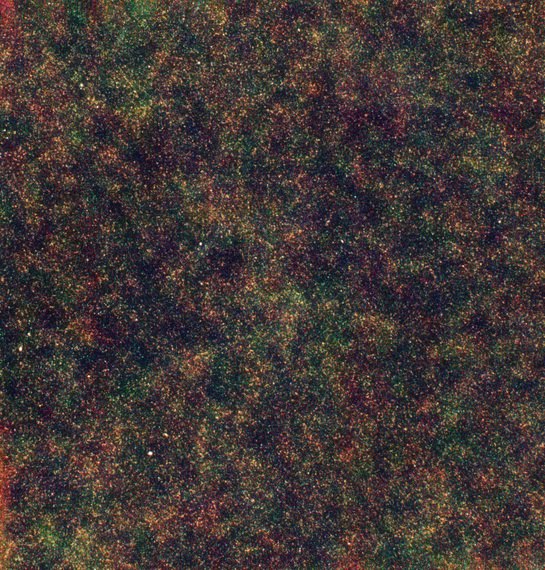[/caption]
Wow. Just wow. Each of the colored dots in this new image from the Herschel telescope is a galaxy containing billions of stars. These are distant luminous infrared galaxies, and appear as they did 10–12 billion years ago, packed together like grains of sand on a beach, forming large clusters of galaxies by the force of their mutual gravity.
“These amazing new results from Herschel are just a taste of things to come, as Herschel continues to unlock the secrets of the early stages of star birth and galaxy formation in our Universe,” said Dr. David Parker, Director of Space Science and Exploration at the UK Space Agency.
The galaxies are color coded in blue, green, and red to represent the three wavebands used for Herschel’s observation. Those appearing in white have equal intensity in all three bands and are the ones forming the most stars. The galaxies shown in red are likely to be the most distant, appearing as they did around 12 billion years ago.
For more than a decade, astronomers have puzzled over strangely bright galaxies in the distant Universe. These luminous infrared galaxies appear to be creating stars at such phenomenal rates that they defy conventional theories of galaxy formation.
Now ESA’s Herschel infrared space observatory, with its ability for very sensitive mapping over wide areas, has seen thousands of these galaxies and pinpointed their locations, showing for the first time just how closely they are sardined together.
The mottled effect in the image gives away this clustering. All the indications are that these galaxies are busy crashing into one another, and forming large quantities of stars as a result of these violent encounters.
This image is part of the Herschel Multi-tiered Extragalactic Survey (HerMES) Key Project, which studies the evolution of galaxies in the distant, ancient Universe. The project uses the SPIRE (Spectral and Photometric Imaging REceiver) instrument on Herschel and has been surveying large areas of the sky, currently totalling 15 square degrees, or around 60 times the apparent size of the Full Moon.
This particular image was taken in a region of space called the Lockman hole, which allows a clear line of sight out into the distant Universe. This ‘hole’ is located in the familiar northern constellation of Ursa Major, The Great Bear.
HerMES will continue to collect more images, over larger areas of the sky in order to build up a more complete picture of how galaxies have evolved and interacted over the past 12 billion years.
Sources: UKSA, Online Showcase of Herschel Images


I’ll second that. “The Galaxies, Like Dust” (to paraphrase Asimov).
Say, that is an interesting prediction, having early star formation rate affected by a “density” effect.
Correction in the title: Should be Stars, not galaxies…
Oh…wow…
Ah, a Brian Aldiss reference. Sweet!… 🙂
But I wonder: how wide is this image? Far less than a full moon, right? How less?
@RCSI, what??? You can’t see stars…
How many galaxies are there? 400 000???
What about those 2 pairs of mega-grains bottom left?
So much Universe that is large beyond imagining but so little ways to explore it 🙁 But we can stare in awe.
Jaw-dropping vastness and enormity – brings tears to my eyes. Nancy, as Jorge says, can we have the field of view please – just to rub it in (can’t see anything on the Herchel site) .
My god. It’s full of stars!
Really thought provoking image. It reminds me of some abstract art I’ve seen.
“WOW!” is right, if not an understatement? The Herschel Telescope web page claims a field of view (FOV) for the telescope is 4 X 8 arc minutes, but this image may be a composite of several images?
An arcminute is 1/60th of a degree, so a 4 X 8 arc minute view would be ~1/15 degree X 2/15 degree. Prettay teensy weensy by any scale! The angular size of your thumb at arm’s length is ? 1 degree….
… that equals a godzillion number of total galaxies out thar! HO!
The term ‘Dust in the wind’ comes to mind…
And how can anyone say there is no one else out there. This is mind-blowing.
Wait a minute… wait a minute.. I see something in soft focus! Yes.. this image is obviously an atomic microscope image of God’s brain. That makes our solar system the size of an electron orbiting an atom inside a neuron there? What fun!
I had a moment of connection to something unfathomable…
I see words! We…. apologize…. for … the …. inconvenience….
Mind blowing. Completely.
Does anyone know what the field of view of this actual image is? I can’t find it stated anywhere explicitly and don’t know enough about the technical details posted to tell if I should be able to work it out from there.
The release mentions that, “the project uses the SPIRE (Spectral and Photometric Imaging REceiver) instrument on Herschel and has been surveying large areas of the sky, currently totalling 15 square degrees, or around 60 times the apparent size of the Full Moon”, but given the statement about “this particular image” I’d have to guess this one is smaller. Any ideas?
Hey, you carbon copies, I’m back ;-0
AWESOME doesn’t quite describe the image it… right!?
2 specs immediately had my attention like @RCSI already pointed out.
WHAT COULD THAT BE???
forget the …it …
This is one of those jaw dropping moments which come once a year.
Then I think, how many of those specs are looking back at us?
How big is the Lockman Hole? Does the image cover the whole of the hole?